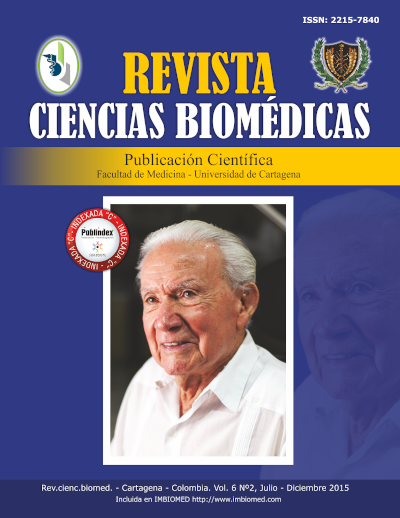Enclavijamiento cefalomedular en el manejo de fracturas inestables de cadera
Enclavijamiento cefalomedular en el manejo de fracturas inestables de cadera
Contenido principal del artículo
Resumen
Introducción: las fracturas inestables intertrocantéricas de cadera en el adulto mayor son problemas de salud pública. Su manejo se realiza con osteosíntesis con clavos cefalomedulares, de los cuales existen varios diseños.
Objetivos: determinar si hay diferencias en los resultados clínicos con el uso de clavos
Targon-PF y hoja espiral TFN.
Metodología: se realizó estudio por conveniencia, prospectivo, en 69 pacientes adultos que presentaron fractura intertrocantérica inestable. Los pacientes fueron llevados a cirugía para osteosíntesis con clavo cefalomedular. Fueron divididos en dos grupos: [A] implante de dos tornillos a cuello (Targon-PF) y [B] Hoja espiral (TFN). Para ambos grupos se realizó técnica quirúrgica convencional y se evaluó el tiempo quirúrgico, sangrado, complicaciones intraoperatorias, resultados de funcionalidad y consolidación clínica y radiológica.
Resultados: se realizó seguimiento promedio de 23 meses. Con el uso de uno u otro implante, no se observaron diferencias estadísticamente significativas en el retorno de la funcionalidad. Fueron más frecuentes las complicaciones Cut Out y mal posición en el grupo Targon-PF, sin diferencia significativa. Fue menor el tiempo quirúrgico con el TFN, 62.4 ± 15.7 minutos mientras que con Targon-PF fue 86.5 ± 31.7 minutos, p<0.0002.
Conclusión: no se observaron diferencias significativas en los resultados clínicos con el uso de clavos Targon-PF y hoja espiral TFN. Rev.cienc.biomed. 2015; 6(2):265-271
Palabras clave
Descargas
Datos de publicación
Perfil evaluadores/as N/D
Declaraciones de autoría
- Sociedad académica
- Universidad de Cartagena
- Editorial
- Universidad de Cartagena
Detalles del artículo
Referencias (VER)
Bucholtz R, Heckman J, editors. Rockwood and green’s fractures in adults, 5th ed. Boston: Lippincott Willian and Wilkins; 2007.
Schmith A, Teague D, Callaghan J. Orthopaedic knowledge update,4th ed. Illinois: American Academy of Orthopaedic urgeons; 2010.
Miyamoto R, Kaplan K, Levine B, Egol K, Zuckerman J. Surgical management of hip fractures: an evidence-based review of the literature. I: Femoral Neck Fractures. J Am Acad Orthop Surg.
;16(10):596-607.
Lindskog D, Baumgaertner M. Unstable intertrochanteric hip fractures in the elderly. J Am Acad Orthop Surg. 2004; 12(3):179-190
Martinez C, Escobar G (ed). Proyecciones nacionales de población, Colombia 1950-2025. Bogotá D.C. Colombia. DANE 1991:1-73.
Othman Y. Assessment of a newly designed dynamic condylar screw with an angle of 102° in treatment of unstable intertrochanteric fractures. Eur J Orthop Surg Traumatol. 2004;14: 225-229.
Nurmi I, Narinem A, Luthje P, Taninem S. Functional outcome and survival after hip fracture in elderly: a prospective study of 106 consecutive patients. J Orthopaed Traumatol. 2004; 4: 7-14
Nikkel L, Edward J, Black K. Impact of comorbidities on hospitalization cost following hip fracture. J Bone Joint Surg Am.2012;94(1):9-17.
Herrera J, Martinez A. Results of osteosynthesis with the ITST nail in Fractures of trochanteric region of the femur. Int Orthop 2008; 32(6):767-772.
Kevin J. Pugh, M. Intracapsullar hip fractures. Jeffrey S. editor Orthopaedic Knowledge Update 9. Illinois: American Academy of Orthopaedics Surgeons;2008. 399-411
Kenneth J. Koval A, Zuckerman,J. Hip fractures: II. Evaluation and treatment of intertrochanteric fractures. J Am Acad Orthop Surg. 1994;2:150-156.
Kyle RF, Cabanela ME, Russell TA, Swiontkowski MF, Winquist RA, Zuckerman JD, Schmidt AH, Koval KJ. Fractures of the proximal part of the femur. Instr Course Lect. 1995;44:227-253.
O’Neil F Condon F, McGloughlim T, Lenehan B, Coffey J, Walsh M. Dynamic hip screw versus DHS blade a biomechanical comparison of the fixation achieved by each implant in bone. J Bone Joint Surg Br. 2011; 93(5):616-621.
Evans E. The treatment of trochanteric fractures of the femur. J Bone Joint Surg Br. 1949; 31(2):190-203.
Miyamoto R, Kaplan K, Levine B, Egol K, Zuckerman J. Surgical management of hip fractures: an evidence-based review of the literature. II: Intertrochanteric Fractures. J Am Acad Orthop
Surg 2008;16(11):665-673.
Harrington K. The use of methylemethacryl as an adjunct in the internal fixation of unstable comminuted intertronchanteric fractures in osteoportoic patients. J Bone and Joint Surg. 1975;57:744-750.
Bridle S, Patel A, Bircher M. Fixation of intertrochanteric fractures of the fémur: A randomised prospective comparison of the gamma nail and the dynamic hip screw. J Bone Joint Surg Br.
;73:330-334.
Adams C, Robinson C, Court-Brown C, McQueen M. Prospective randomized controlled trial of an intramedullary nail versus dynamic screw and plate for intertrochanteric fractures of the fémur. J Orthop Trauma. 2001;15(6):394-400.
Pajarinen J, Lindahl J, Michelsson O, Savolainen V, Hirvensalo E. Pertrochanteric femoral fractures treated with a dynamic hip screw or a proximal femoral nail: A randomised study comparing
post-operative rehabilitation. J Bone Joint Surg Br. 2005;87(1):76- 81.
Nuber S, Schönweiss T, Rüter A. Stabilisation of unstable trochanteric femoral fractures: Dynamic Hip Screw (DHS) with trochanteric stabilization plate vs. proximal fémur nail (PFN) [German]. Unfallchirur. 2003;106(1):39-47.
Bruijn K, Hartog D, Tuinebreijer W. Reliability of predictors for screw Cut out in intertrochanteric hip fractures. J Bone Joint Surg Am. 2012; 94(14):1266-1272.
Gary-Villa E, De la Peña O, Solano A. Resultados del tratamiento de fracturas intertrocantericas inestables con clavo cefalomedular bloqueado. Revista Colombiana de Ortopedia y Traumatologia. 2008;22(1):60-66.



 PDF
PDF
 FLIP
FLIP





